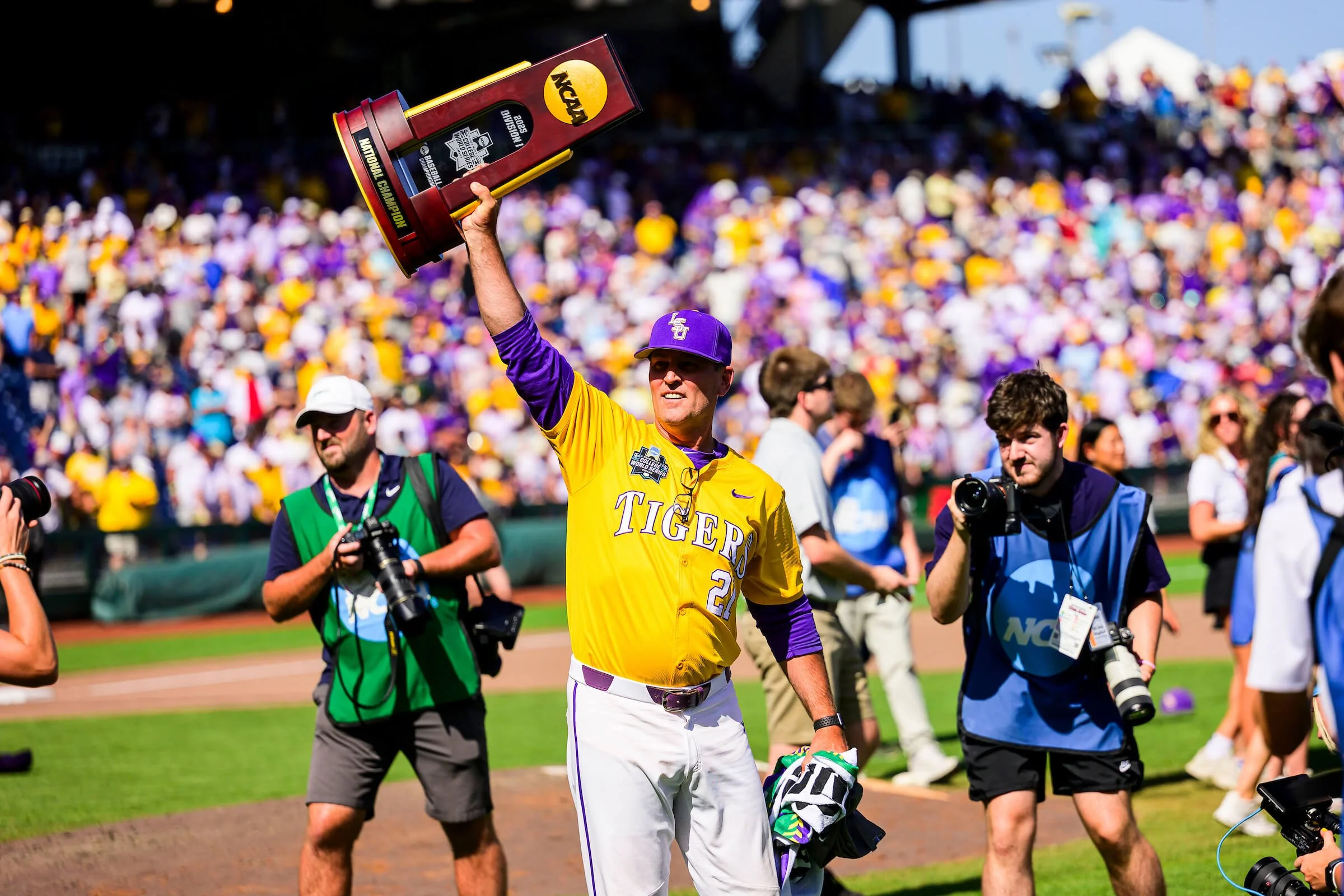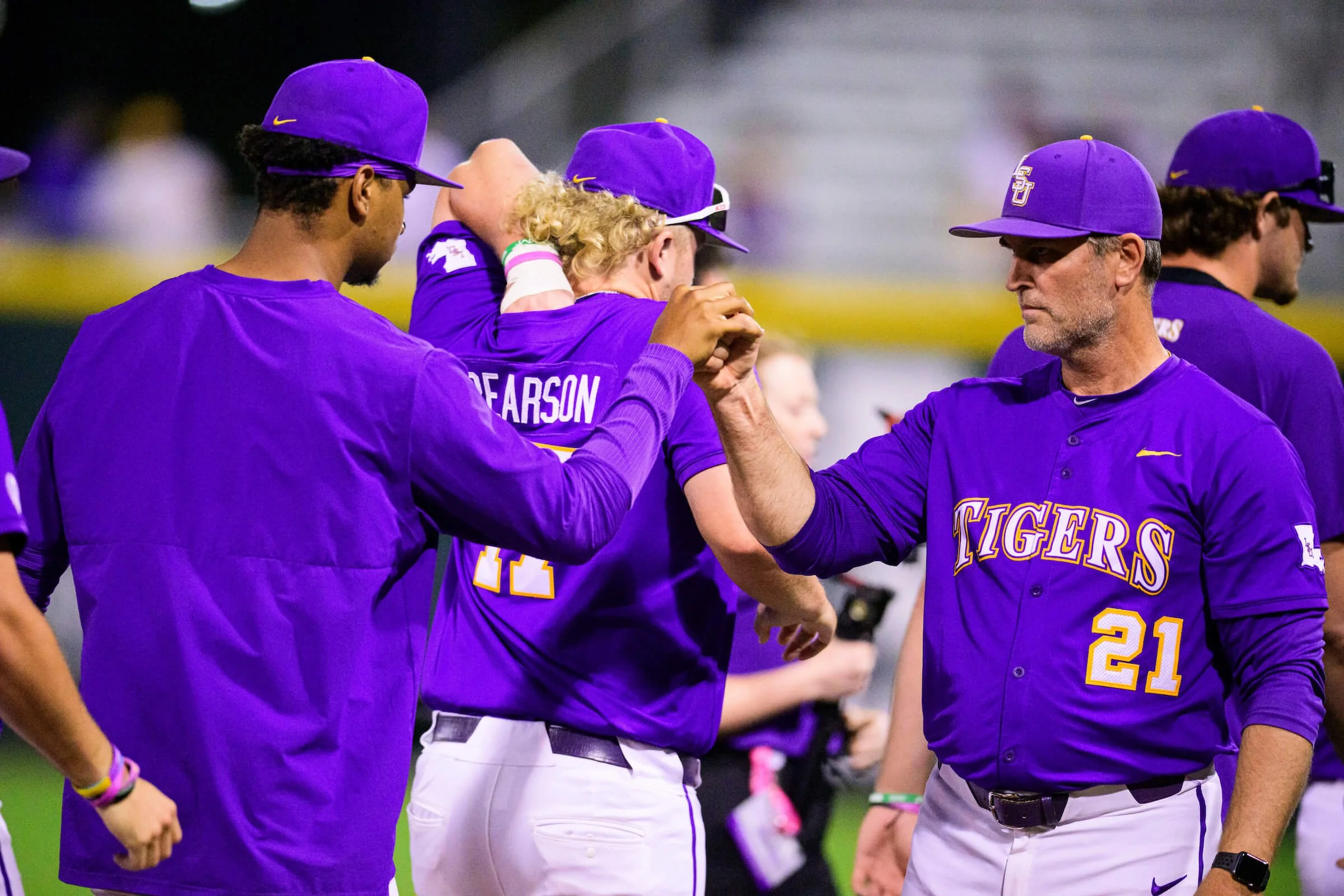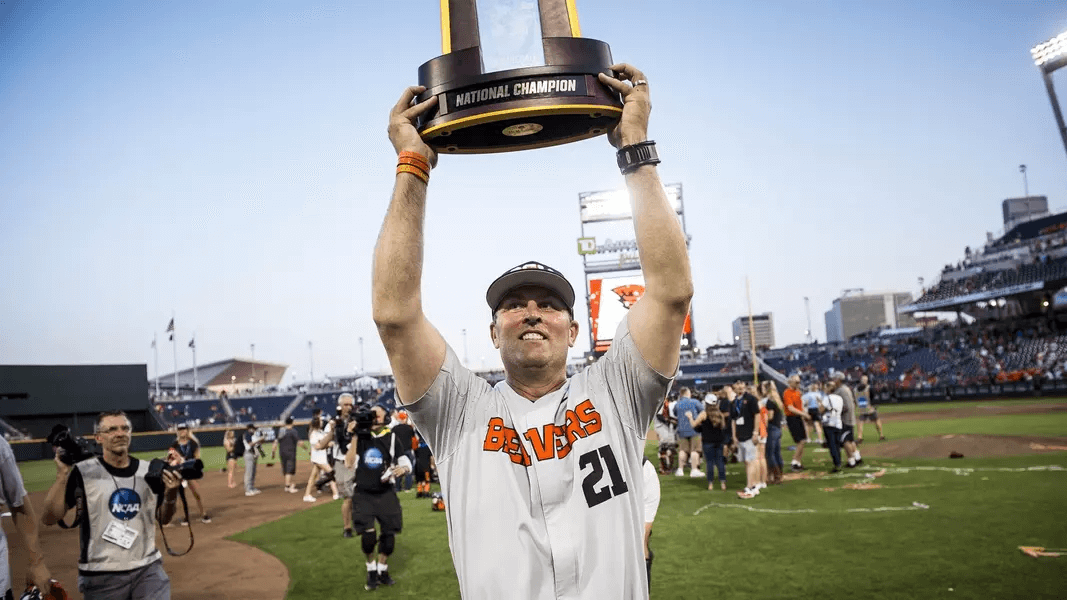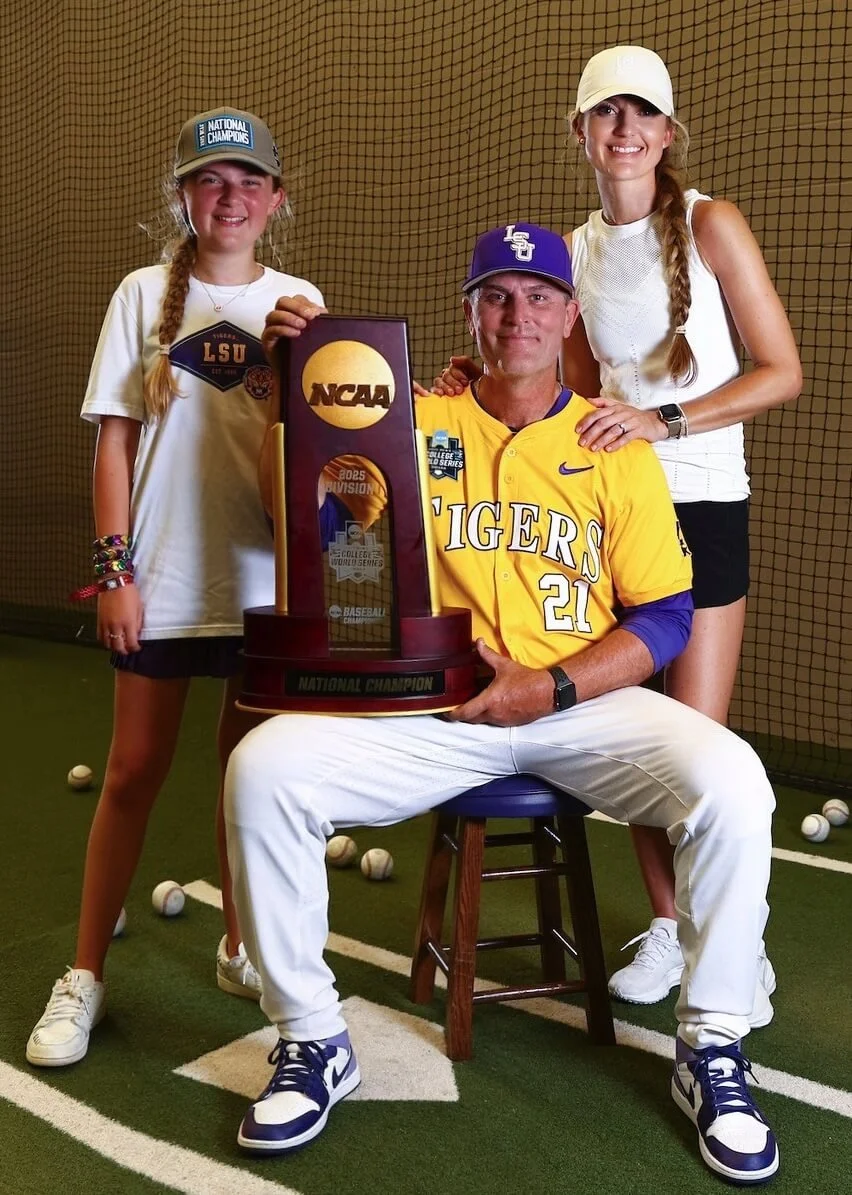How is it to win a second College World Series ring? Great, says Nate
LSU pitching coach Nate Yeskie hoists the championship trophy after the Tigers beat Coastal Carolina in the 2025 College World Series at Omaha (courtesy LSU sports communications)
There aren’t many times a pitching coach gets to hoist a national championship trophy after the final game of a College World Series.
Once is amazing. But twice?
“Pretty cool,” says Nate Yeskie, who has now won CWS titles with Oregon State and Louisiana State. “Those things never get old.”
In 2018, Yeskie was pitching coach when Oregon State claimed its third national championship by beating Arkansas in the CWS finals. In June, he duplicated the feat as LSU’s pitching coach, with the Tigers knocking off Coastal Carolina for the title.
“The experience of doing it somewhere that you haven’t done it before exposes you to a whole ‘nuther world,” says Yeskie, who completed his second season at LSU in 2025. “I had been there before with a different program, so you know what to expect, but at the same time, you don’t. It’s different.
“The last game in Omaha (in ’25) felt like a home game because of the volume of fans we had there, and their excitement in us winning it all.”
And how did this one compare to winning one at Oregon State?
“It’s like having kids,” Yeskie told me from Long Beach, Calif., where he was scouting prospects at the Area Code Games. “You don’t love any one more or less than the other. They are just different.
“Both times, I have tried to be as present as I could. You want to hang out with the kids you have coached, to be able to absorb it in the moment you are there. Because once you leave the stadium and get on that airplane home, it is over with, and you are on to the next season.”
Yeskie has coached in six College World Series with four schools — three with Oregon State (in 2013, ’17 and ’18) and one apiece with Arizona (2021), Texas A&M (2022) and LSU. Only one other coach has made it to Omaha with four different programs — Tom Holliday, who made the CWS with Arizona State, Oklahoma State, Texas and North Carolina State.
“I don’t think it is just that I have been betting on the right horse,” Yeskie says with a laugh. “There is some truth to that, I guess. But at the same time, you have to get the kids you have to play at the level they are capable of and get them to understand what it is going to take to have success.
“Every job offers a different challenge, but it is still the same goals — to work hard and play well. And you have to catch a break at some point, too.”
Yeskie began his coaching career with three seasons at his alma mater, Nevada-Las Vegas from 2005-07. By far the longest stint of his career was at Oregon State (2009-19), followed by two-year stops at Arizona, Texas A&M and LSU.
In 2024, eight of Yeskie’s LSU pitchers were drafted, including three in the top three rounds. The Tigers’ pitching staff this past season was led by Kade Anderson, a 6-2, 185-pound sophomore left-hander who finished 12-1 with a 3.18 ERA and 180 strikeouts in 119 innings. He was chosen by the Seattle Mariners with the third pick in the Major League draft last month.
Yeskie (right) coached two of the best pitchers in the country in Anthony Eyanson (left) and Kade Anderson (courtesy LSU sports communications)
“What a tremendous young man,” Yeskie says. “As a human being, he is every bit as good if not better than the player, and that is saying something.”
The Washington Nationals took Oklahoma shortstop Eli Willits with the first pick in the draft, “but Kade might have gone first had (the Nationals) not fired their GM (Mike Rizzo),” Yeskie says. “Had they kept (Rizzo), there is a decent chance Kade would have been the guy. Seattle hit a home run with that one.”
LSU’s Saturday starter was nearly as good. Anthony Eyanson, a 6-2, 210-pound junior right-hander, was 12-2 with a 3.00 ERA and 152 K’s in 108 frames. Eyanson, a third-round pick, reaped a $1.75 million signing bonus with the Boston Red Sox.
“Anthony probably should have gone a little bit higher,” Yeskie says. “He got paid like a second-rounder. On our staff, those guys were 1 and 1A. There were times when Anderson would throw pretty decent, and Eyanson would throw better behind him the next day.”
Was it the best pitching tandem Yeskie has had through 20 years of college coaching?
“There certainly hasn’t been any (duo that was) better,” he says. But then he brings up the names of some of the arms he coached while at Oregon State.
“There was a run there when we had Ben Wetzler, Matt Boyd and Andrew Moore,” he says. “There was another time when Jace Fry was in the discussion, and (Luke) Heimlich and (Drew) Rasmussen. (Bryce) Fehmel put up monster numbers and won a lot of games. I guess you can slice it different ways.”
Yeskie points out that Boyd and Rasmussen were MLB All-Stars this season, and that Moore and Fry pitched in the big leagues.
“Kade and Anthony have some work to do to catch up with those guys,” Yeskie says. “But I won’t be surprised if we have the same kind of discussion about them five to 10 years from now.”
It seemed like a good time to pin Yeskie down: Who was the best pitcher he coached at OSU?
Eight of them made the big leagues: Boyd, Rasmussen, Moore, Fry, Josh Osich, Sam Gaviglio, Brandon Eisert and Cam Booser. (I don’t remember Booser at all, but he pitched six early-season games for the Beavers as a freshman in 2011 before having Tommy John surgery and transferring to Central Arizona JC after the season.) Heimlich, the National Pitcher of the Year in 2018, certainly would have been a big-leaguer, too, he not been blackballed professionally for sex crimes against a niece he allegedly committed (and in my opinion, was falsely accused of) as a teenager.
“I would put Boyd and Rasmussen right there with Luke among the best ever,” Yeskie says. “Boyd was the Swiss Army knife of the whole batch because of his ability to start and relieve. Jake Thompson went 14-1 and led the nation in wins as a junior in 2017. By the time Wetzler and Fehmel got to years three and four, they packed up a lot of wins, too.”
Heimlich and Wetzler are OSU’s career leaders with 36 wins, followed by Fehmel with 33. Moore, Fry, Wetzler, Heimlich and Thompson were all first-team All-Americans. Heimlich was a two-time Pac-12 Pitcher of the Year. Fry was the only other one to win that award.
“I am not going to pick one,” Yeskie says finally, “because I can’t.”
Yeskie served as pitching coach for a decade under Pat Casey at Oregon State, then for another year under Pat Bailey before leaving for Arizona. Yeskie had great success at OSU, winning Collegiate Baseball’s National Pitching Coach of the Year award in 2013 and ’17 and the D1Baseball Assistant Coach of the Year Award in ’17. His staff that season had a collective 1.93 ERA, a school record and best in the country. It was a great time in Nate’s life.
“Loved it,” he says. “Case, Bailes — I learned a lot from those guys. Still stay in touch with them. I met my wife (Brittney) there. My daughter (AJ) was born the morning that we beat Arizona in extra innings.
“The people of Corvallis were great. The fans were great. I loved (former Beaver coach) Jack and Jean Riley — and there were others. I have some close friends who lived there and played for the Beavers. I saw Mike Thurman today. I stay in touch with Bill Rowe. I saw Ryan Gorton in Omaha. I see Bryce Fehmel all the time.”
In 2018, Yeskie earned his first College World Series ring while at Oregon State (courtesy OSU sports communications)
Yeskie pauses.
“To live in a place as long as we were (in Corvallis), it will always hold a special place in our hearts,” he says.
Yeskie has no real connection to Oregon State baseball now, however, or to the coaching staff led by Mitch Canham.
“I don’t know any of the kids who are there now,” he says. “I saw (the Beavers) in Omaha. Mitch has done a good job playing the hand he was dealt with in the changing of the conference, but I don’t follow it that closely. I put a lot of time, effort and attention into things I can control. That is where my head is at now.”
Yeskie is in his fourth season working under LSU head coach Jay Johnson, who was at Arizona when Yeskie coached there in 2020 and ’21. Johnson left after the ’21 season for LSU — hours after Yeskie had committed to Texas A&M.
“Jay got the (LSU) job a few hours after I had come to an agreement with A&M,” Yeskie says. “He called to ask if I were interested, but it was too late. I couldn’t back out of that. That is not the way to handle business, to give them your word to do something and not do it.”
Eventually, Yeskie found his way back to Johnson.
Nate with daughter AJ and wife Brittney (courtesy LSU sports communications)
“Jay is great — a lot like Case was,” Yeskie says. “He lets me do my job. Gives me the freedom to give him input from a program standpoint, too. He values what I might see, for instance, in an infielder. We talk about hitters and positioning. There are a lot of good baseball discussions. It’s not one of those deals where he says, ‘Just handle the pitching,’ and that’s it.
“That is one of those things that I appreciated so much about Case. We are all baseball coaches. If you see something that is going to help a kid get better and help our team win, why wouldn’t you have those discussions?”
Under Casey, the assistants all had recruiting areas.
“I coached pitchers, but my area covered where (Steven) Kwan and (Trevor) Larnach were from, and (after scouting them) I said, ‘These guys can hit,’ ” Yeskie says. “Conversely, Bailes is watching pitchers who are in his territory. He watched Kevin Abel throw and said, ‘This guy is hard to hit.’ He was right.”
How does coaching in the SEC compare to coaching in the old Pac-12?
“You have to take it year by year, but it is different in a lot of ways,” he says. “There is a physicality to some of the kids in the SEC. In the old Pac-12, if the count was 2-0 to a six-hole guy, you might see bunt. If it is 2-0 to the six-hole guy at Mississippi State, he is not bunting. He is looking for a pitch he can do damage on. The style of play is different. You don’t see a lot of the short game in the SEC. And every team has 95 (mph) arms. The 12th guy on a staff is at 95.”
Oregon State ranked among the top 20 nationally in home attendance with nearly 4,000 a game this past season, but the Southeast Conference covered the entire top 10 list. No. 1 was LSU, which averaged 11,185 last season at Alex Box Stadium, capacity 10,326. That’s right — standing-room-only tickets filled the stadium nearly every game. The Tigers have led the nation in attendance 26 times since 1996.
“We play Louisiana Tech on a Tuesday night and there are 10,000 people there,” Yeskie says. “There is always a buzz. It is more than a buzz; it’s a roar. We had rain delays this year of several hours, and games didn’t start until 10 at night, and there were still 10,000 people there. We had two games when we walked off at 1:15 in the morning, and the decibel level and the sound of the crowd was that of a Saturday game at 3 in the afternoon.
“It just means more to the fan base and the people there. Part of it is the absence of major league sports. There is no MLB team in Louisiana. The closest ones are the Houston Astros and Texas Rangers. The people are more likely to wear an LSU Tigers hat than a Houston Astros hat. They are connected to our kids and to our program.”
One player who will be wearing an LSU hat next season is third baseman Trent Caraway, who transferred after two years at Oregon State.
“He fits a need for what we were looking for, some help on the right-hand side of the batter’s box,” Yeskie says. “He has some familiarity with high-level pitching. He shined on the back end of their (2024) season. He is a proven performer against quality arms.”
The Tigers have won national titles in two of the last three seasons. Can they do it again in 2026?
“We are going to be tough,” Yeskie says. “There is no shortage of talent. I don’t know that we will ever replace the front end of the rotation we had last season, but we have young players who are talented, and they will go through their developmental stage. We got beat up in the (MLB) draft — lost eight or nine incoming (freshmen) — but we like the players we have.”
SEC baseball is a minefield, however. LSU (19-11) tied for third with Vanderbilt in league standings in 2025, behind Texas and Arkansas.
“You are challenged every weekend,” Yeskie says. “(The opposing) Friday pitchers are dynamite, but Saturday and Sunday guys are going to be draft prospects, too. You are running into talent every game.”
Yeskie, who turns 51 on Wednesday, has had schools reach out to him about head coaching positions.
“I don’t think they were the right places,” he says, “and certainly not at the right time.”
Does becoming a head coach remain an aspiration?
“You never say never,” Yeskie says. “You have to find the right place that you believe is a good fit for you and is going to give you an opportunity to do it right. Until that happens, you do your job where you are at to the best of your ability. You don’t think about those things. If you do, you lose sight of where you’re at.”
► ◄
Readers: what are your thoughts? I would love to hear them in the comments below. On the comments entry screen, only your name is required, your email address and website are optional, and may be left blank.
Follow me on X (formerly Twitter).
Like me on Facebook.
Find me on Instagram.




